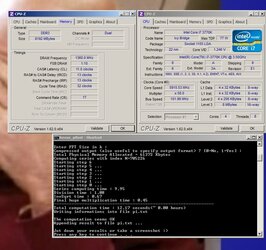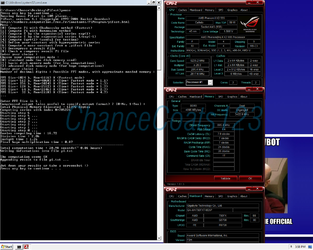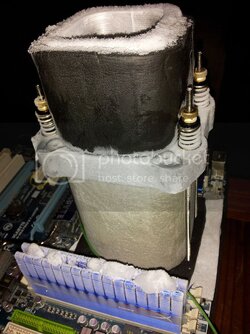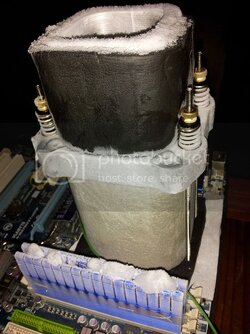-
Welcome to Overclockers Forums! Join us to reply in threads, receive reduced ads, and to customize your site experience!
You are using an out of date browser. It may not display this or other websites correctly.
You should upgrade or use an alternative browser.
You should upgrade or use an alternative browser.
Marathon: January PiFast
- Thread starter bmwbaxter
- Start date
- Joined
- Feb 1, 2009
- Location
- Illinois
Nice score.
Looks like Ln2 may be needed to beat you guys. Some good scores!
I'm always lurking... Linky

But I think I'll be competing in the AMD section this month. I'm not going to push my 3770k on DIce again until I know it's true LN2 potential. And besides. If I bench AMD, then you guys can watch.
- Joined
- Oct 13, 2010
Man I want that Chip 5.9 at 1.24v........Nice run dude.
- Joined
- Oct 14, 2012
^^^^^ 1.73v on waterhow is that thing not dead yet????
She's a tough one
- Joined
- Oct 13, 2010
Just messing with you.... , It was a good run that's for sure....go OCF....
, It was a good run that's for sure....go OCF....
 , It was a good run that's for sure....go OCF....
, It was a good run that's for sure....go OCF....
That isn't right. Its sitting around 1.75 - 1.8v. Not sure why it read so low for that run...
- Joined
- Jul 29, 2011
- Location
- Buenos Aires, Argentina
Delidded? I've seen 1.85v done on a Hyper 212 evo delidded, with 0c ambient temp.
- Joined
- Feb 1, 2009
- Location
- Illinois
I have almost no control over how much voltage I use, and even I wouldn't go over 1.5 on air no matter what the ambient temp. Air coolers are relatively inefficient, and the ambient doesn't have a very large effect on the actual temperature of the die, which is what counts.
- Joined
- May 10, 2009
That's a complicated subject. With a standard (solid, no-heatpipe) heatsink deltaT die to air should remain fairly static as ambient temp changes.
However, heatpipe efficiency is best in a certain window. Using water as the working fluid (which computer heatpipes do) means that the best efficiency is had starting at around 40c up through right around 100c. Mind you that's heatpipe temps, which are rarely much over the ambient.
Below 40c the efficiency drops off, until at 0c (again, heatpipe temp) it drops to zero when the water inside the heatpipes freezes.
Just above 0c the heatpipe functions, but rather poorly.
For really cold ambient benching a solid copper heatsink with a ton of airflow will stomp a heatpipe heatsink into the ground.
If you use ammonia in heatpipes the efficiency window starts at something more like -30c or -40c if I recall correctly. Unfortunately due to the substantially higher cost (for ammonia, also for safe handling of ammonia and licenses and such) you won't find any heatsinks that use it.
Ambient still matters heavily with heatpipes, but the difference between a 15c ambient and a 5c ambient isn't nearly as large as 25c to 15c.
However, heatpipe efficiency is best in a certain window. Using water as the working fluid (which computer heatpipes do) means that the best efficiency is had starting at around 40c up through right around 100c. Mind you that's heatpipe temps, which are rarely much over the ambient.
Below 40c the efficiency drops off, until at 0c (again, heatpipe temp) it drops to zero when the water inside the heatpipes freezes.
Just above 0c the heatpipe functions, but rather poorly.
For really cold ambient benching a solid copper heatsink with a ton of airflow will stomp a heatpipe heatsink into the ground.
If you use ammonia in heatpipes the efficiency window starts at something more like -30c or -40c if I recall correctly. Unfortunately due to the substantially higher cost (for ammonia, also for safe handling of ammonia and licenses and such) you won't find any heatsinks that use it.
Ambient still matters heavily with heatpipes, but the difference between a 15c ambient and a 5c ambient isn't nearly as large as 25c to 15c.
untouched.Delidded? I've seen 1.85v done on a Hyper 212 evo delidded, with 0c ambient temp.
- Joined
- Jul 29, 2011
- Location
- Buenos Aires, Argentina
That's a complicated subject. With a standard (solid, no-heatpipe) heatsink deltaT die to air should remain fairly static as ambient temp changes.
However, heatpipe efficiency is best in a certain window. Using water as the working fluid (which computer heatpipes do) means that the best efficiency is had starting at around 40c up through right around 100c. Mind you that's heatpipe temps, which are rarely much over the ambient.
Below 40c the efficiency drops off, until at 0c (again, heatpipe temp) it drops to zero when the water inside the heatpipes freezes.
Just above 0c the heatpipe functions, but rather poorly.
For really cold ambient benching a solid copper heatsink with a ton of airflow will stomp a heatpipe heatsink into the ground.
If you use ammonia in heatpipes the efficiency window starts at something more like -30c or -40c if I recall correctly. Unfortunately due to the substantially higher cost (for ammonia, also for safe handling of ammonia and licenses and such) you won't find any heatsinks that use it.
Ambient still matters heavily with heatpipes, but the difference between a 15c ambient and a 5c ambient isn't nearly as large as 25c to 15c.
But isn't the water inside the heatpipes in a different pressure enviroment much like refrigerant inside a fridge's compressor and thus the boiling point is lower? Does it freeze even like that?
untouched.
Suicided samurai...
- Joined
- Feb 1, 2009
- Location
- Illinois
- Joined
- May 10, 2009
Yeah the water is all the is in the heatpipe. Some in vapor form, some in liquid. No air, nothing else. The boiling point is much higher than 100c as the pressure goes up with the temp (at 100c you'll have one atmosphere of pressure in there), but the freezing point is unchanged as it takes pressure to lower the freezing point and what the heatpipe has in it is vacuum.
- Joined
- Jun 9, 2010
- Thread Starter
- #139
Updated!! ChanceCoats123 is now leading the AMD Division! Lots of good scores everyone in the last few days!!
Looks nice! Did you just put some Dice directly on your RAM?
Looks nice! Did you just put some Dice directly on your RAM?
- Joined
- Oct 14, 2012
Updated!! ChanceCoats123 is now leading the AMD Division! Lots of good scores everyone in the last few days!!
Looks nice! Did you just put some Dice directly on your RAM?
My score wasn't updated...

Similar threads
- Replies
- 77
- Views
- 5K
- Replies
- 37
- Views
- 3K
- Replies
- 40
- Views
- 4K
- Replies
- 27
- Views
- 2K
- Replies
- 53
- Views
- 5K





